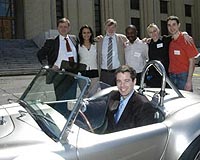 |
Stanford CA (SPX) May 13, 2009 A hydrogen-rich compound discovered by Stanford researchers is packed with promise of helping overcome one of the biggest hurdles to using hydrogen for fuel--namely, how do you stuff enough hydrogen into a volume that is small enough to be portable and practical for powering a car? The newly discovered material is a high-pressure form of ammonia borane, a solid material which itself is already imbued with ample hydrogen. By working with the parent material at high pressure in an atmosphere artificially enriched with hydrogen, the scientists were able to ratchet up the hydrogen content of the material by roughly 50 percent. "Including the hydrogen already stored in ammonia borane, this new material can store around 30 weight percent in total," said Yu Lin, lead author of a paper describing the work that was published this week in the online edition of Proceedings of the National Academy of Sciences. The Department of Energy has set a target for hydrogen-powered vehicles of having an on-board storage system able to store 9 percent, by weight, of hydrogen in 2015. The new compound, called ammonia borane-hydrogen, contains more than triple that amount. But the fly in the hydrogen is that the sought-after storage system must function at ambient pressure and temperature conditions. The process Lin used to get the added hydrogen into the ammonia borane has to take place at a minimum pressure that is approximately 60,000 times the usual pressure at the surface of the Earth. "For energy applications, we need to stabilize the material near ambient conditions," said Lin, a graduate student in geological and environmental sciences. Currently, most hydrogen-powered machines use either compressed hydrogen gas or liquid hydrogen, which needs to be maintained at high pressure or very low temperature, respectively, relative to ambient temperature and pressure. These methods have associated safety concerns in the case of compressed hydrogen and require significant energy for cooling in the case of liquid hydrogen. There is currently no material that satisfies all of the requirements for on-board fuel storage for hydrogen-powered vehicles, according to Lin, who is working with Wendy Mao, assistant professor of geological and environmental sciences at Stanford and a co-author of the paper. "If the material can be stabilized at or near ambient conditions with a large amount of hydrogen content, then I think it will be very promising," Lin said. There are potentially several ways to help stabilize the compound under normal temperature and pressure conditions. One idea is that there might be some "alternative chemical paths, like adding some catalyst to try to stabilize the system," Lin said. If Lin and Mao succeed, ammonia borane could move one step closer to becoming an everyday storage material for hydrogen. Also closer to a reality would be scientists' and environmentalists' dream of powering cars with oxygen from the air and hydrogen from the fuel cell, while pumping out only water from the exhaust pipe. Share This Article With Planet Earth
Related Links Stanford University Car Technology at SpaceMart.com
 Montreal To Revamp Battery-Powered Vehicles
Montreal To Revamp Battery-Powered VehiclesMontreal, Canada (SPX) May 08, 2009 Thousands of small electric scooters, bicycles and wheelchairs throughout Europe and Asia are powered by LifePO4 - a material used in advanced lithium-ion batteries developed by Universite de Montreal researchers. "It's a revolutionary battery because it is made from non-toxic materials abundant in the Earth's crust. Plus, it's not expensive,'" says Michel Gauthier, an invited professor at ... read more |
|
| The content herein, unless otherwise known to be public domain, are Copyright 1995-2009 - SpaceDaily. AFP and UPI Wire Stories are copyright Agence France-Presse and United Press International. ESA Portal Reports are copyright European Space Agency. All NASA sourced material is public domain. Additional copyrights may apply in whole or part to other bona fide parties. Advertising does not imply endorsement,agreement or approval of any opinions, statements or information provided by SpaceDaily on any Web page published or hosted by SpaceDaily. Privacy Statement |